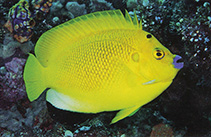| Family: |
Pomacanthidae (Angelfishes) |
| Max. size: |
26 cm TL (male/unsexed) |
| Environment: |
reef-associated; marine; depth range 3 - 60 m, non-migratory |
| Distribution: |
Indo-West Pacific: East Africa south to 28°S (Ref. 33390) and east to Samoa, north to southern Japan, south to Australia. |
| Diagnosis: |
Dorsal spines (total): 14-14; Dorsal soft rays (total): 16-18; Anal spines: 3-3; Anal soft rays: 17-19. Description: Body short and deep, and strongly compressed. Preorbital bone convex and without strong spines. Overall color is bright yellow with a broad black band on the edge of the anal fin and a broad white zone above it. A black spot is on the forehead and a ocellated dark spot just behind the head; the lips are blue. Juveniles have a false eye-spot at the base of the soft dorsal fin and a thin black line over the head, running through the eye (Ref. 48636). Body depth 1.6-1.8 in SL. Scales longitudinal series 38-47 (Ref. 90102). |
| Biology: |
Inhabits lagoon and seaward reefs (Ref. 9710); found near coral (Ref. 5953). Feeds mainly on sponges and tunicates (Ref. 1602). Juveniles secretive and occur below 25 m (Ref. 37816). Adults in small but loose groups at moderate depths (Ref. 48636). Frequently exported through the aquarium trade (Ref. 48391). |
| IUCN Red List Status: |
Least Concern (LC); Date assessed: 08 October 2009 Ref. (130435)
|
| Threat to humans: |
harmless |
Source and more info: www.fishbase.org. For personal, classroom, and other internal use only. Not for publication.
